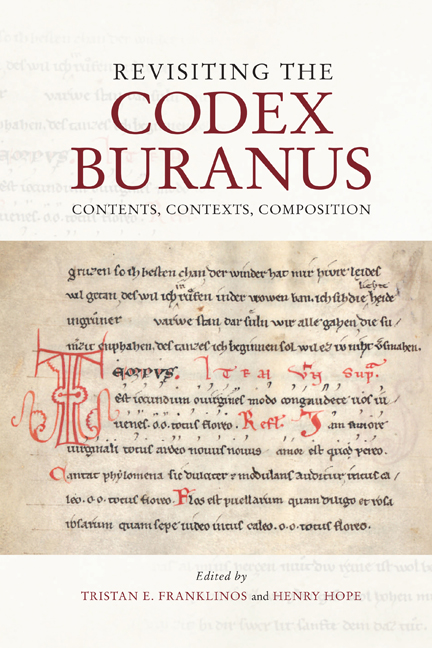Book contents
- Frontmatter
- Contents
- List of Illustrations
- Acknowledgements
- Abbreviations
- Dedication
- Introduction: The Codex Buranus – A Unique Challenge
- Chapter 1 A Modern Reception History of the Codex Buranus in Image and Sound
- Chapter 2 Parody in the Codex Buranus
- Chapter 3 Satire in the Codex Buranus
- Chapter 4 ‘Artes Amatorie Iam Non Instruuntur’: Learned and Erotic Discourse in the Carmina Burana
- Chapter 5 Classical Learning and Audience in the Carmina Amatoria: A Case-Study on CB 92
- Chapter 6 Rape, the Pastourelle, and the Female Voice in CB 185
- Chapter 7 Rethinking the Carmina Burana III: The Poetry of Peasants
- Chapter 8 Predestination and God’s Grace: The Salvific Architecture of the Religious Songs in the Codex Buranus
- Chapter 9 Revisiting the Plays of the Codex Buranus
- Chapter 10 Revisiting the Music of the Codex Buranus
- Chapter 11 Locating the Codex Buranus: Notational Contexts
- Chapter 12 Plurilingualism in the Codex Buranus: An Intercultural Reconsideration
- Chapter 13 Compilation, Contrafacture, Composition: Revisiting the German Texts of the Codex Buranus
- Afterword: multiformis armonia, scolaris symphonia
- List of Manuscripts
- Bibliography
- Index
- General Index
- Studies in Medieval and Renaissance Music
Chapter 10 - Revisiting the Music of the Codex Buranus
Published online by Cambridge University Press: 16 September 2020
- Frontmatter
- Contents
- List of Illustrations
- Acknowledgements
- Abbreviations
- Dedication
- Introduction: The Codex Buranus – A Unique Challenge
- Chapter 1 A Modern Reception History of the Codex Buranus in Image and Sound
- Chapter 2 Parody in the Codex Buranus
- Chapter 3 Satire in the Codex Buranus
- Chapter 4 ‘Artes Amatorie Iam Non Instruuntur’: Learned and Erotic Discourse in the Carmina Burana
- Chapter 5 Classical Learning and Audience in the Carmina Amatoria: A Case-Study on CB 92
- Chapter 6 Rape, the Pastourelle, and the Female Voice in CB 185
- Chapter 7 Rethinking the Carmina Burana III: The Poetry of Peasants
- Chapter 8 Predestination and God’s Grace: The Salvific Architecture of the Religious Songs in the Codex Buranus
- Chapter 9 Revisiting the Plays of the Codex Buranus
- Chapter 10 Revisiting the Music of the Codex Buranus
- Chapter 11 Locating the Codex Buranus: Notational Contexts
- Chapter 12 Plurilingualism in the Codex Buranus: An Intercultural Reconsideration
- Chapter 13 Compilation, Contrafacture, Composition: Revisiting the German Texts of the Codex Buranus
- Afterword: multiformis armonia, scolaris symphonia
- List of Manuscripts
- Bibliography
- Index
- General Index
- Studies in Medieval and Renaissance Music
Summary
Music is a performative art with a transitory character. As such, music can be interpreted – in analogy to Klaus Lazarowicz's model for the theatre – as a ‘triadic collusion’ between composer, performer, and audience. There have been a range of attempts to capture the transitory nature of music's content: notes and scores are used as means to determine a composer's construction; technical equipment records phonographic minutiae of a performer's interpretation; and the audience has gained access to mechanical instruments – analogue and digital – allowing them perpetually to recreate and re-experience (differing) performative interpretations of a single composition. Against this backdrop, a reconsideration of the Codex Buranus and its music requires scholars to probe into the triad of its producers (composers, performers, audiences), and into the compositional structures and technical possibilities of putting the music on record.
My doctoral research on the Carmina Burana, published in 2000, focussed on the process of notating the songs within the manuscript – comparing all known musical concordances of the songs – and considered whether the music preserved in the codex was prescriptive and functioned as a model for performances, or descriptive and could be seen as a (rough) transcription of a musical performance. The study's main aim was to cut through to the ‘original’ songs as best as possible, leaving aside their subsequent reception, be it Orff's cantata, or the musicological infatuation with their medieval concordances. As far as the music is concerned, there is no way of reproducing the songs of the Codex Buranus in their historically authentic form; nonetheless, it made sense in my earlier work to describe the Carmina Burana as a musical corpus of its own quality and with its own musical aesthetics.
Every generation has its own way of questioning the past – depending on its own ambitions, interests, socio-economic context, and historical knowledge. After almost twenty years of scholarly abstinence on my part, a musical consideration of the Carmina Burana thus requires rethinking, given the changed perception of music brought about by technological progress and music's increased accessibility across different types of media.
Information
- Type
- Chapter
- Information
- Revisiting the Codex BuranusContents, Contexts, Compositions, pp. 251 - 282Publisher: Boydell & BrewerPrint publication year: 2020
